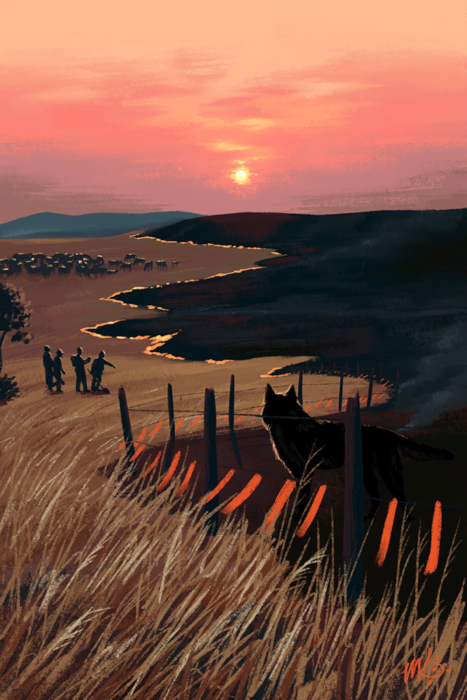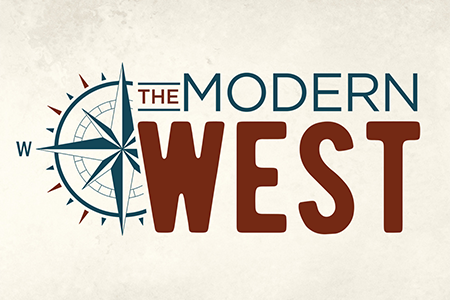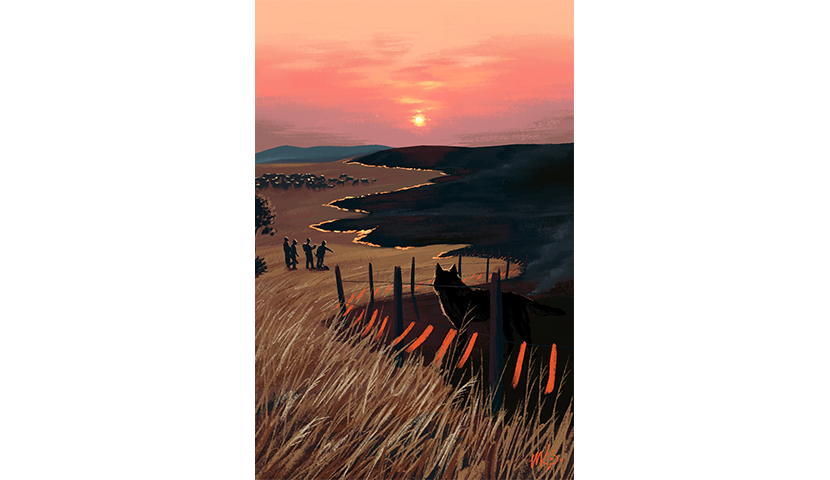
Bitterroot is partnering with the The Modern West podcast to examine the resilience of Western people and towns. This is Part 1 in the series.
Part 2: This New Mexico Town is the Next Adventure Hub. Can it Quit Fossil Fuels?
Part 3: Out of the Wilderness: Guides are Teaming Up to Prevent Suicides
Part 4: This Oregon Town is a Hotbed of Latinx Political Leadership
When she was 10 years old, Cindy Super’s father burned down her favorite patch of Douglas fir trees, which she and her siblings called Fairyland. The arson wasn’t intentional. Super’s father had started a small fire to clear some weeds while she and her mother attended church in Missoula, almost 40 miles from the family’s property in Montana’s Blackfoot River basin. The wind picked up, though, and spread flames to the children’s woodland oasis. Fairyland was torched.
Super’s first encounter with prescribed fire would not be her last. As coordinator of the forestry program for the Blackfoot Challenge, a community conservation group in western Montana’s Blackfoot River watershed, Super is overseeing prescribed burns on a much larger — and, hopefully, more successful — scale.
The native forests, grasslands, and wetlands of this 1.5 million-acre ecosystem are still relatively undeveloped; public ownership and conservation easements on private property ensure that much of the landscape will remain largely intact. To keep the ecosystem healthy as possible, the Blackfoot Challenge provides landowners and ranchers with an array of programs and tools that make both their operations and the watershed itself more resilient to stressors like wildfire, drought, and predation.
These distinct programs work because of a common ingredient: landowners who buy into collaboration and have a willingness to experiment alongside state and federal agencies, conservation nonprofits, and each other.
“Having a community that works well together and works well with partners has facilitated a resilient landscape,” said Challenge Executive Director Seth Wilson. “It provides livelihood opportunities for the rural ranching community and forestry, and a really amazing ecosystem. … It’s had huge benefits, both ecologically and for rural sustainability.”
From our sponsor

How wild should our wild places be? Hear the story of a rancher in Wyoming who’s grappling with this question on The Modern West podcast.
Decades of heavy grazing, timber harvesting, and mining had, by the early 1990s, turned the Blackfoot River into a polluted waterway barely able to sustain its once-robust trout runs. But some watershed landowners and ranchers had already spent two decades discussing ways to fix these problems. In 1993 — a year after American Rivers called the Blackfoot one of the most at-risk watersheds in the country — they would form the Blackfoot Challenge.
Over the next 27 years, the Challenge helped clean up the river and transform it into one of the state’s foremost trout fishing destinations. The area’s timber stands are more resilient to fires now, and landowners share water cutbacks during times of drought. The public has benefited from access to hunting and fishing on private land. Ranchers’ responses to wolves and bears here — thanks in no small part to Wilson’s work — have become a model for conservationists and ranching collaboratives around the West.
The Challenge’s board includes representation from the Blackfoot’s timber and ranching industries, landowners, conservation nonprofits, financial institutions, and state and federal land management agencies. The separate staff is composed of various program coordinators and land and resource stewards.
In 2001, Wilson joined the Challenge as its first wildlife coordinator, and helped implement its groundbreaking strategy of deterring grizzly bears and wolves not by shooting them, but with nonlethal methods such as electric shock, fladry, and range riders. “It’s an effective tool,” Wilson told me. “It doesn’t harm the [predators], it doesn’t do any damage, but it creates a learned negative experience, such that it won’t be repeated.”
The Challenge serves as a sort of laboratory for property owners and land management agencies alike, and coexisting with wolves and grizzlies remains a key component of the group’s work. Eric Graham, now the Challenge’s wildlife coordinator, oversees various programs at the cutting edge of predator adaptation. His range riders explore grazing lands for sign of nearby predators; if cattle are in danger, they report it to the rancher. When livestock die, the Challenge composts the carcasses, thus depriving hungry carnivores of a free meal.
Graham’s latest project is a collaboration with the U.S Fish and Wildlife Service and Montana Fish, Wildlife, and Parks to test an in-ground electrified steel mat system, which would replace traditional swing gates on fences. These mats would allow tires and rubber work boots to pass by seamlessly, but four-pawed trespassers would receive a nonlethal jolt.
“It’s easy to just throw your hands up and want to ‘shoot, shovel and shut up,’” Graham said, referencing the long-held motto of killing any predator that threatens cattle. “But folks are realizing that these bears are here to stay, and we need to figure out how to live with them.”
Other programs focus on the Blackfoot River itself. A warming climate has snowpack melting off earlier in the year, making drought conditions the new normal, according to Blackfoot Challenge Water Steward Jennifer Schoonen. Montana water law prioritizes older water rights, which can leave junior rights holders without irrigation water during times of shortage. And in the Blackfoot, which the state has designated a Blue Ribbon fishery, MFWP has an in-stream flow right that supersedes many on the river. That means the state could tell basin water users with junior rights to stop taking water during a drought to maintain the fishery’s health.
But the Blackfoot Drought Response Plan, implemented in 2000, prevents such measures in all but the most extreme circumstances. As long as enrolled users are implementing water conservation plans, MFWP won’t call on them to stop irrigating when the Blackfoot hits the low-flow trigger of 700 cubic feet per second. Instead, the program’s 100 or so participants enact predetermined, graduated cutbacks, which allows all of them — not just senior rights holders — to use some water in mild or moderate drought conditions.
“The Blackfoot Drought Response Program only works because of this community ethic,” said Schoonen. “Resilience will also depend on the public and private partnerships at the heart of many Blackfoot projects and programs – partnerships that leverage the best resources and expertise of diverse landowners and stakeholders.”
Few know the value of these partnerships better than Blackfoot rancher and board member David Mannix, whose family ranch in Helmville was founded in 1882.
“Our roots are a little bit deep, and sometimes it’s hard to peek out,” said Mannix. “It’s easy to stay focused on what we’ve always done and not see what’s going on, not only across the valley but outside the valley across the world. The Blackfoot Challenge helps us to gain that perspective from a high elevation.”
In addition to the land under family ownership, Mannix holds grazing leases on private, state, and federal lands as well, which means he must keep track of relationships with the different groups he leases from. He is also part of the Drought Response Program, so he shares water with Blackfoot users whose roots aren’t quite as deep as his.
“We have been conditioned to working with others who have different values than us, and we need to learn to respect that,” said Mannix. “That’s what the Blackfoot Challenge does super well.”
The Challenge’s collaborative approach works, in part, because preservation measures by one landowner can benefit her neighbors. A prescribed burn on one plot can protect timber resources on neighboring stands; deterring predators from one fenced property could deter them from other fences. The product, with enough buy-in, is collective resiliency.
In the Blackfoot, you have “a community that’s willing to work together and work with the federal government, the state government, conservation groups,” Wilson said. “The partnerships that we’ve built over 30 years help build that resiliency.”
But that requires folks to try bold ideas — like setting their land on fire. Cindy Super understands why starting fires on purpose might not make sense to most people. But federal and state land management agencies have used controlled burns to reduce wildfire fuel on public lands for years, and Western tribes have employed the practice for generations. The Challenge’s new program helps landowners use the same tactic on their own properties to improve the whole watershed’s chances at surviving uncontrollable blazes.
“It sounds counterintuitive, to burn something to make it more resilient to burning,” said Super. “But we need to bring fire back. If we start to understand more about how much good fire can do in the right situation, people can learn to love it.”
David Atkins owns 159 forested acres in the southern Blackfoot. A 40-plus year veteran of the forestry industry, he instantly saw the need for a few prescribed burns on his landscape. He joined a working group organized by the Challenge and other partners, and conducted a successful six-acre burn at the end of April. The next step was a larger 45-acre burn, requiring more people and resources. But the weather shifted at the last second, disabling the day’s activities.
“That happens,” Atkins said. “It’s always frustrating though, because you gear up, spend money, you have people working equipment … then you have to call it off and go home.”
This potential for failure is always present in landscape resiliency projects. In rare instances, prescribed burns could shift with one gust of wind, torching a neighboring forest or house. Range riders could miss signs of predation or downed fences, resulting in livestock loss. Even the “shared shortage” nature of the Blackfoot Drought Response Plan evaporates if the river reaches an extremely low level.
But Blackfoot residents still see the value in working toward landscape resiliency. And when the efforts are successful, everyone is happy.
“You have to neighbor up and partner up. If you aren’t doing that…you are the opposite of resilient,” said Challenge board chair and Ovando rancher Jim Stone. “Collaborative conservation is messy and not fun sometimes. But when you see it work, it’s the coolest thing you’ll ever run into.”
In this landscape shaped by collective action, the next coolest thing might be when experiments don’t quite work, but inform future conservation.
That’s the story the charred Fairyland tree skeletons tell.
This story has been edited to better reflect MFWP’s in-stream water rights.

